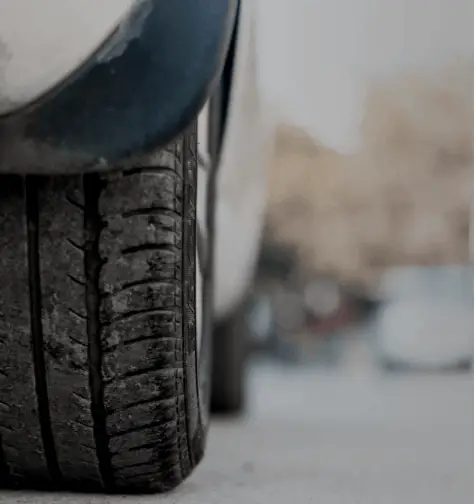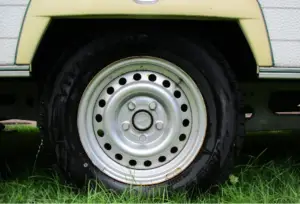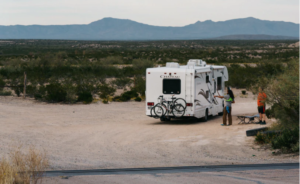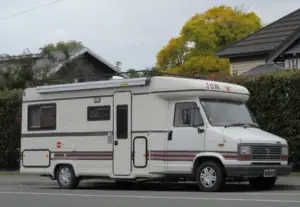RV Tire blow out is scary and you should do everything to prevent it. The basic maintenance of the RV includes checking on tires for wear and tear, setting correct pressure and checking on the tread of the tire.
In most cases, RV tires blow out as a result of overloading, under-inflation or aging tire with very low tire tread. Many other factors like uneven wear, un-noticed puncture, wrong tire size, overheating, misalignment also contribute towards a tire blow out.
There are several other reasons that can cause blow out and knowing them and taking action can help prevent it. In this article, lets find out why do RV tires out and how you can avoid it.
Overloading
Just because you are going on a vacation doesn’t mean you can bring every item in your home. Imagine the entire family bringing all they can think of with them, and how plenty of stuff that is.
It should really equal to a lot of load for the RV. RVs also have a load/weight suggestion or the weight of the load to be carried inside. Do not exceed the weight limit. Pack the RV to keep the weight to the minimum.
Your RV will have weight ratings like Gross Vehicle Rating (GVW), Gross Vehicle Weight Rating (GVWR), Gross Axle Weight (GAW) and few more. GVW is the weight of the RV when fully loaded. You should not exceed this and stay within the limits always. The weight limits are more important in case of travel trailers.
Read : How much do travel trailers weigh
This is important to know how much the RV can only hold, hence, there is a need to keep the load in the middle of its capacity or just below the suggested weight limit.
Under-inflation and Over-Inflation

If the tire pressure is too low, there is tendency of the surface area of the tire to touch the road and therefore will create friction, and friction causes overheating in the tire.
With very little air inside your R tires will start to heat and reduce the longevity and untimely blow out. Right tire inflation will cause longevity to your tire besides making travel safe at all times.
Overinflated tires too can lead to quick wear and tear, resulting in early blow outs. If you are heading for a long journey then its always better to check the tire pressure before starting out.
Too much pressure on tires will result in tread and sidewalls becoming harder. This means the traction and performance of the tires reduces causing uneven wear on tires. Overall the tires wear out abnormally and quickly. This obviously will result in blow out at any time.
A pressure gauge or pressure monitoring system is therefore a good tool to have in your RV tool box. Setting up correct PSI on RV or travel trailer tires should be taken more seriously by RVers.
The tip here is to keep the tires inflated at correct PSI recommended by your RV and tire company. Take technical advice from your RV technician if you have any doubt on the correct PSI.
The correct tires pressure (PSI) is normally recommended by the RV manufacturer. These calculations happen based on the RV weights ratings like GVWR. In most travel trailers the PSI is normally in the range of 40 PSI to 65 PSI.
Punctures
Unfamiliar elements are on the road, sometimes there are even small nails or unnamed sharp objects that can puncture our tires.
Though sometimes this sharp object just clings to our tire over time there is the danger of the tire getting punctured and causing it to blow up.
Even if a tire patch is used, the tire will not work efficiently. You are also not confident of running your RV at the right speed for fear that your tire will blowout anytime.
So, every time you are on the road, you should be extra careful to evade any object you see on the road, just to be on the safe side.
Old tires
As with every tire, the RV tire should be checked as often as possible. Especially if it’s being used most of the time for vacations. Aging tires should be checked and replaced on time.
Old tires will cause you many problems eventually. Old tires, worn out, and in poor condition are just asking for trouble.
Although you are frequently checking your tires with every trip, there is a tendency that your tire has reached its full life capacity if you had it with you for many years. The best thing to do is to invest in newer tires just to stay on the safe side.
During summer season the chances of tires blow out are higher as tires get hot quickly.
Uneven Tire Wear
Some RV users will have their front tire changed and the other tires remain. Since the tires are uneven there is a tendency for the old tires to fail and blow up.
This will be an enormous problem for you especially if you are on the road for your vacation.
Low Tire Tread
Tires get bald if the tires reach 2/32 of an inch deep it already is as compared to new tires with 10/32 of an inch. The tires will have a slightly smooth appearance as the grooves disappear because of frequent and long use.
This is where the tire loses its traction on the road as the tire cannot efficiently channel water out and the snow traction also decreases. Without traction, the protection of the tire from skidding through the ice and water disappears.
Read : How to protect RV tires
Mechanical Issues
Bent axles or wheel bearing that are loose can cause early wear and tear of the tires. Misalignment of the tires too can result in issues that will result in reducing the tire life.
Axle misalignment may not easily visible to your eyes. This has to be checked at a professional center. It is not something to do as a physically inspection.
Therefore always go to the service center that are trusted. Most such mechanical issues are straight forward for professionals and can be corrected after proper detection. Thus, make sure you have that appointment with the professional as per manufacturer recommended schedule.
Dry Rot
RV’s are usually left parked outside and exposed to different weather elements. The tire shows cracks as if it is getting dried up if left long under the sun. This may be unsafe for you to drive. Once the cracks are in the tire cords, long-distance driving will be dangerous.
This can still be saved if caught just in time for you to do something with the tires. As long as the damage is not yet too deep you can still dab a sponge in a water-based degreaser and apply carefully on every part of the tire that has signs of wearing out.
You can apply the degreaser twice before you can rinse the tire with lukewarm water and air dry after.
You can then park the RV somewhere with a shade to protect it from direct sunlight.
Wrong RV tire size
There are times you will not buy a brand new RV but would rather buy the used one. You need to check the tire quality before buying the RV or ask the seller whether they already changed the tire and which tire has been replaced.
You may also ask professional help so you will confirm whether the tire size is correct and if every tire is in tip-top shape. Yes, you may drive an RV with different tire size but it will not be long before you are having tire blowouts during your travel.
Preventing Blow Out and Maintenance

Tire blowouts can happen even in other vehicles and will always be because of the condition your tire is in. Taking great care and maintaining rv tires is much essential.
1. Avoid Overloading : Do not overload the RV. Its all coming down on the tires. Pack the RV or travel trailer responsibly. Follow a checklist for packing, avoid all unwanted things that increase the weight.
2. Replace aging tires : As soon as you know the tire is old enough go ahead and replace it. DO the tire rotation as well, but replace immediately when its time. Average life of RV tires can vary a lot.
Most tires have an average life of 4-6 years but varies a lot on many factors. Also, the tire life is from the manufacturing date and not the date when you start using it. Tires will have the date printed on them, do check it out before getting the new one on your RV.
Read : How long do travel trailer tires last
Usually when you get the tire from reputed seller you should get it 1 or 2 months from the manufacturing date.
3. Do Complete Check : It is very well-advised that you should always do a complete check-up and maintenance of your vehicle. You can even hire a professional if you don’t have the skills to check or to do the maintenance yourself. A little precaution is better than having to fix the problem later, goes the saying.
4. Know the Weather : Also, the weather can contribute to any incidents on the road, so the better for you to have your tire checked as often as needed. In summer season the chances are higher due to increased heat.
5. Check for portholes or debris on road. Keep an eye on any unwanted elements on the road that can cause puncture in the tire.
6. Set the Correct tire PSI. Do check the tire pressure before starting out with the journey. If the travel is very long then do take halt in between to have a look at tires. Visit the technician if you have any doubt and get the tires inspected. Get a tire pressure monitoring system.
7. Rotate the tires : This is very nice tips that tire manufacturers also recommend. Rotate the tires for few thousand miles. This will help in increasing the tire life by reducing uneven tire wear.
8. Cover RV Tires : Covering the tires using RV tire covers can help in keeping UV and sunlight exposure to the minimum. UV is a major tire degradation factor. Avoid exposing the tires to UV or dry or wet conditions in storage as much as possible.
9. Keeping tires off ground can help. When the RV has lot of weight inside, it can be a great idea to keep the tires off ground.
10. Take Breaks to Check : When on a long journey even during normal travel do check on tires when you take the break.
Even though you did a thorough check pre-departure, things can get wrong while traveling. Therefore every time you take a break from driving, do a quick visual inspection of all tires.
While you Drive down the road
Always drive slowly or safely. Taking into consideration the road condition and the weather. Keeping in mind the speed limit and even if there are few vehicles on the road, always follow the speed limit.
Remind everyone to buckle up. Those in front highly need to buckle up. For those at the back, as long as there are seat-belts fastened, everyone should use this. If anyone has something to do or needs to move for a bit, the RV should be safely parked on the side first.
Keep a safe distance from other vehicles. The RV should be at a distance. A 2-second rule is the safest distance to follow. The 2-second rule means if you are driving a 10-feet vehicle a 1-second rule is an ideal distance, but the RV is most often 20 feet, the 2-second rule will be followed.
In Conclusion :
RV Tire blow out can be avoided by following simple inspection and regular maintenance. Keeping the RV light and under the weight limits will make a great difference.





